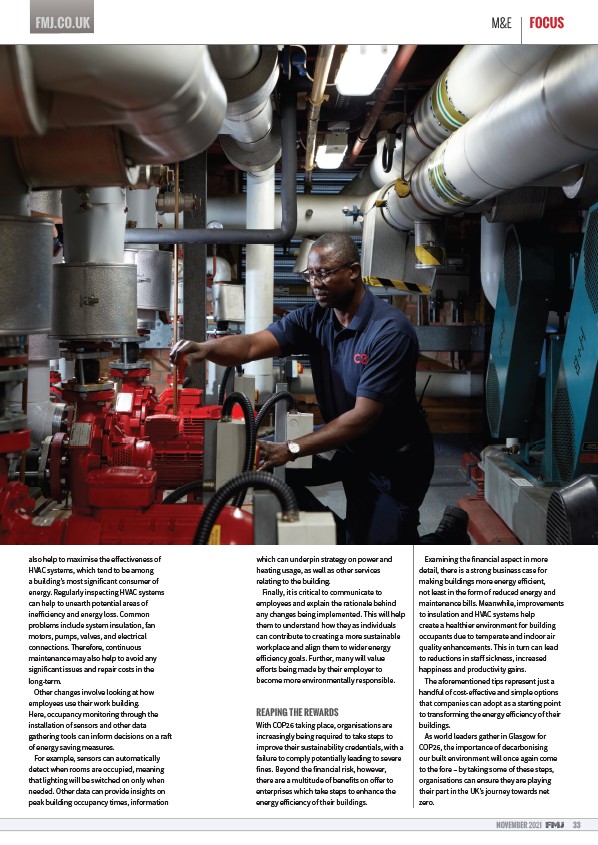
FMJ.CO.UK M&E FOCUS
NOVEMBER 2021 33
also help to maximise the e£ ectiveness of
HVAC systems, which tend to be among
a building’s most significant consumer of
energy. Regularly inspecting HVAC systems
can help to unearth potential areas of
ine£ iciency and energy loss. Common
problems include system insulation, fan
motors, pumps, valves, and electrical
connections. Therefore, continuous
maintenance may also help to avoid any
significant issues and repair costs in the
long-term.
Other changes involve looking at how
employees use their work building.
Here, occupancy monitoring through the
installation of sensors and other data
gathering tools can inform decisions on a ra•
of energy saving measures.
For example, sensors can automatically
detect when rooms are occupied, meaning
that lighting will be switched on only when
needed. Other data can provide insights on
peak building occupancy times, information
which can underpin strategy on power and
heating usage, as well as other services
relating to the building.
Finally, it is critical to communicate to
employees and explain the rationale behind
any changes being implemented. This will help
them to understand how they as individuals
can contribute to creating a more sustainable
workplace and align them to wider energy
e£ iciency goals. Further, many will value
e£ orts being made by their employer to
become more environmentally responsible.
REAPING THE REWARDS
With COP26 taking place, organisations are
increasingly being required to take steps to
improve their sustainability credentials, with a
failure to comply potentially leading to severe
fines. Beyond the financial risk, however,
there are a multitude of benefits on o£ er to
enterprises which take steps to enhance the
energy e£ iciency of their buildings.
Examining the financial aspect in more
detail, there is a strong business case for
making buildings more energy e£ icient,
not least in the form of reduced energy and
maintenance bills. Meanwhile, improvements
to insulation and HVAC systems help
create a healthier environment for building
occupants due to temperate and indoor air
quality enhancements. This in turn can lead
to reductions in sta£ sickness, increased
happiness and productivity gains.
The aforementioned tips represent just a
handful of cost-e£ ective and simple options
that companies can adopt as a starting point
to transforming the energy e£ iciency of their
buildings.
As world leaders gather in Glasgow for
COP26, the importance of decarbonising
our built environment will once again come
to the fore – by taking some of these steps,
organisations can ensure they are playing
their part in the UK’s journey towards net
zero.